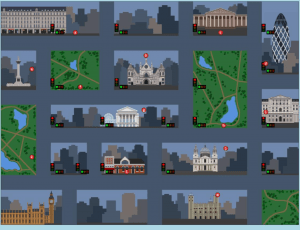Bus Bots Online Game for the London Transport Museum
Executive Summary
The London Transport Museum (LTM) aims to both preserve and showcase the heritage of London’s transport systems and encourage future engineers by fostering curiosity in both the transport industry and STEM. In order to address the growing need for STEM skills in the UK by inspiring passion for engineering in their young visitors, the LTM’s Learning Team has established a number of interactive activities for school groups and families. Each activity is designed to teach valuable engineering skills to its participants. Our team was brought in to create such an activity, one that incorporates digital technology as well as teaches its participants about programming. The activity was to be designed to encourage adaptation, creative problem- solving, teamwork, and systems thinking, as well as be engaging and enjoyable. It also needed to be extensible, made both for a short drop-in activity and a longer workshop.
In order to design and create this activity, we first evaluated the best practices in the design of digital museum interactives through research and interviews with LTM Learning Team member Elizabeth Poulter. At her request, we looked into the ‘tinkering’ teaching technique as guidance on how to create a program that teaches engineering skills to children. We determined more specific and varied design criteria through interviews with the Learning Team, with Telent (the activity sponsor), and with appropriate third parties. We then developed, tested, and refined prototypes of the original activity; first developing an original design plan and then receiving feedback through video calls and surveys. We made improvements to this prototype based on the feedback we received. We also developed and delivered training guidance on the activity for the LTM staff, creating documentation on the activity’s design and how to run it. Lastly, we made physical prototype recommendations for future extensions to the activity after talking to the LTM staff and doing our own individual research.
Our main deliverable is the source code of a fully-functional digital, screen-based activity prototype that incorporates our findings on activity design into its playstyle. It integrates the initial design criteria as well as traffic timing and modelling simulations on behalf of Telent and role distribution and a storyline on advice from the Learning Team.
The activity is run from a web server which shows a large, cartoon-style map of London with various recognizable landmarks, including the Transport Museum. Visible are a number of roads with traffic lights and bus stops labelled “a” through “m” (Figure ES1). This interactive image can be projected on a surface or shown on a large monitor.
Up to four participants can connect to the activity through any device, including the iPads the LTM can supply for controllers. Upon connecting, each controller is assigned one of two different roles: (1) a bus route planner or (2) a traffic light controller. Each bus route controller is given a list of the bus stops, from which they can create a route for their own bus. The traffic light controller is given a selection of block coding statements from which they can build a small, plain-English program for the traffic lights to follow. When each player has completed their tasks, a simulated day begins on the map, where buses follow the assigned routes and traffic lights obey the created program. During the day, simulated passengers will travel to destination stops using the bus routes, and a score will be assigned based on how quickly the passengers were able to travel to their destinations throughout the day. The participants’ goal is to achieve as high of a score as possible with the most efficient bus route and traffic systems.
Multiple bus routes with minor points of overlap result in a more efficient route than a single bus route can provide, so the activity encourages participants to work as a team as each bus route planner coordinates their bus route in cooperation with their partners. Meanwhile, the role of the traffic light controller is equally important to the success of the team, as more efficient traffic light programs will lead to higher scores. It is also designed to teach young participants about basic programming procedures and practices. Both roles in conjunction encourage participants to utilize systems thinking. Participants being able to see the simulated day play out encourages them to experiment, learn from their failures in prior simulations, and adapt in creative ways, as there is no predetermined configuration to yield the highest score.
Our team also assembled a list of recommendations to develop this prototype into a full- fledged, polished activity in the future. These developments could take the form of updates to the software to deepen the design and user interface (UI), or even integrate physical components, such as programmable robots, to replace the interactive screen. For example, an option to adjust the difficulty of the game would allow for different visitors to explore the activity in different depths, and Raspberry Pis could be used to construct physical bus robots.




